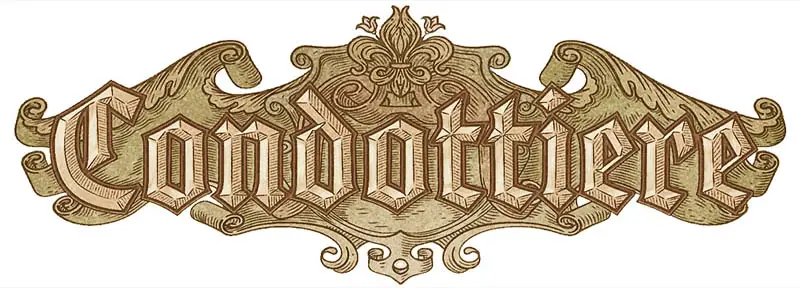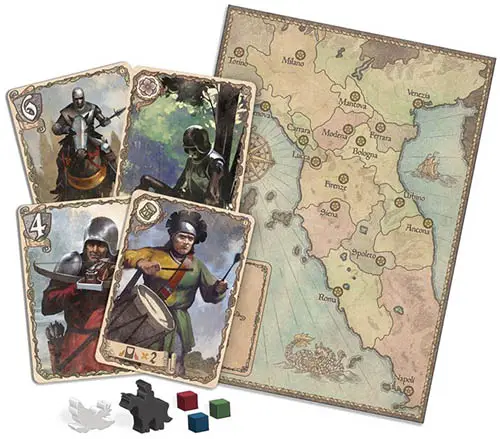
If players wish to have a longer or more detailed game of Condottiere, they can incorporate one or more of the following rules.

Draw After Battle
With this variant, each player draws cards at the end of each battle instead of drawing cards at the end of each round. In fact, with this variant, there are no "rounds" in the game, only a series a battles. When playing with this variant, at the beginning of the game, players start with 7 cards instead of 10 cards.
During the game, battles are concluded following the steps below.
-
Compare Strength (as per the normal rules)
-
Draw Cards
Each player may draw up to 3 cards, but may not exceed his hand limit. A player's hand limit is 10 cards plus 1 additional card for each region that the player controls.
Example: Chris has 9 cards remaining in his hand at the end of a battle and controls 1 region. Therefore, he has a hand limit of 11 cards. He may only draw 2 new cards, since drawing 3 cards would exceed his hand limit.
If at the end of a battle, no players have cards in their hands, then each player draws 10 new cards instead of 3 new cards.
-
Choose the New Battle (as per the normal rules)
-
Discard Battle Lines (as Per The Normal Rules)
With this variant, players do not have the option to discard cards from their hands after each battle.
Playing For Points
This variant adds more strategy and negotiation, since several games are played to determine the overall winner.
The players can decide to assign a score (20 or 30 points, for example) that must be attained over a series of games of Condottiere. Points are assigned at the end of each game in the following manner:
One point for each region a player controls.
If a player wins a game by controlling 3 adjacent regions (4 adjacent regions with 2 or 3 players), he is awarded a bonus of 5 points in addition to the points scored for each region.
Continue playing games until one or more play- ers reach or exceed the designated score. At that point, the player with the most points wins. (If play- ers are tied for points, fight a final battle as per the normal rules).
Note: When playing with this option, we suggest that you do not also use the "Capturing Regions" variant discussed below.
Bigger Kingdoms
This variant increases the game's playing time and makes it more difficult to win by controlling adja- cent regions.
Increase the number of adjacent regions required to win by one. So, for games with 4, 5, or 6 players, 4 adjacent regions are required for victory (but a play- er still wins if he controls 5 total regions). In 2- or 3-player game, 5 adjacent regions or 6 total regions are required for victory.

Capturing Regions
This variant allows you to capture regions that are already controlled by another player.
The Condottiere token may now be placed on a region already controlled by another player, but that player (the region's "defender") will benefit from an important advantage in the course of the battle: The region's defender may pass his turn as many times as desired without losing the right to play cards later in the battle.
However, as soon as he has plays his first card, he must follow the normal rules (if he subsequently passes, he will no longer be able to play cards during that battle). This ability allows a region's defender to play cards even after all the other players have passed their turns.
If the battle ends in a tie, the region's defender keeps control of the region and also receives the Condottiere token.
When a player plays a Bishop card, he may either place the Favor of the Pope token on any region (even a region that contains a control marker) or remove the token from the game board.

Hidden Cards
This variant provides a greater element of bluffing. When a players plays Mercenary, Drummer, Heroine, and Courtesan cards, he places them facedown into his battle line. The next time that player plays a card, he turns up any facedown card in his battle line.
However, if a player with a facedown card in his battle line passes, he may choose not to reveal his facedown card. At the end of the battle, before players determine the total strength of their battle lines, all players must reveal their facedown cards. After you play a card, announce the total revealed strength of your battle line (do not count hidden/ facedown cards).
Facedown Mercenary cards may not be retrieved with Scarecrow cards.
If a Bishop card is played, only faceup Mercenary cards are counted. Any hidden Mercenary cards are completely ignored by the Bishop.
Example: In a two-player game, John has two 6- strength Mercenary cards and one facedown 10- strength Mercenary card in his battle line. Scott has one 5-strength and two-1 strength Mercenary cards in his battle line and plays a Bishop card. Since the high- est-strength revealed Mercenary card in play is 6, all 6-strength Mercenary cards are discarded from both players' battle lines. The hidden 10-strength Mercenary card is not affected by the Bishop card.
Continue Reading

